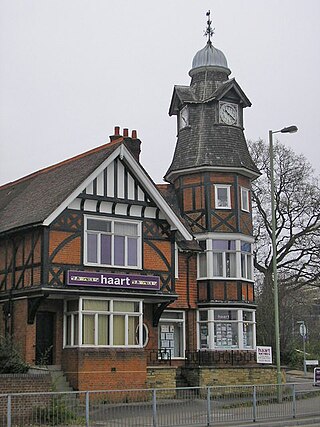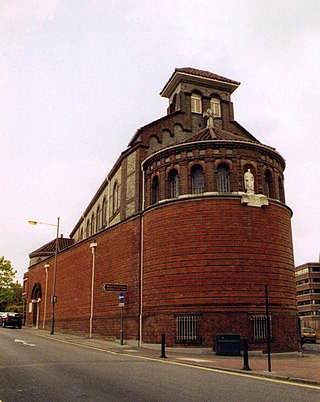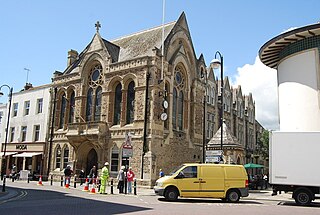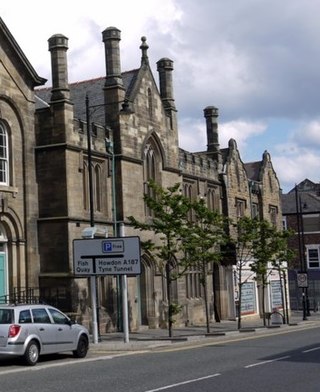
Farnborough is a town in northeast Hampshire, England, part of the borough of Rushmoor and the Farnborough/Aldershot Built-up Area. Farnborough was founded in Saxon times and is mentioned in the Domesday Book of 1086. The name is formed from Ferneberga which means "fern hill". According to the UK-wide 2011 Census, the population of Farnborough is 57,486.

Aldershot is a town in Hampshire, England. It lies on heathland in the extreme northeast corner of the county, 31 mi (50 km) southwest of London. The area is administered by Rushmoor Borough Council. The town has a population of 37,131, while the Aldershot Urban Area, a loose conurbation has a population of 243,344, making it the thirtieth-largest urban area in the UK.

Aldershot Military Museum in Aldershot Military Town in Hampshire, England was conceived by former Aldershot Garrison Commander, Brigadier John Reed (1926–1992). Reed believed that it was essential to preserve the history of the military town and founded the Aldershot Military Historical Trust to raise funds for the establishment of the Museum. Reed acquired the two Victorian barrack bungalows in which the Museum is still based.

St Joseph's Church is a Roman Catholic Parish church in Aldershot, Hampshire. Built in 1913, it is situated at the top of a ridge on Queens Road, overlooking the town centre, between the Municipal Gardens and Princes Hall. It is a Grade II listed building. Sir Nikolaus Pevsner described it as 'One of the most impressive churches of its date, brilliantly planned on a triangular site.'

Municipal Gardens is an urban park in the town of Aldershot in Hampshire. A short walk from the town centre it has been a public park since 1904. In its ornamental garden is the Aldershot Cenotaph which commemorates the town's dead from both World Wars. In 2019 the Cenotaph received Grade II listed status on the Register of Historic England.

The Wesleyan Church is a former Methodist church for the town of Aldershot in Hampshire, England. Closed in 1988 the building has been a Grade II* listed building since 30 April 1981. In use today as offices, a dental studio and a gymnasium, the former Wesleyan Church is situated on the corner of Grosvenor Road and Queens Road in Aldershot.

Leyton Town Hall is a municipal building in Adelaide Road, Leyton, London. The building, which includes Leyton Great Hall, is a Grade II listed building.

The Town Hall, Christchurch is a municipal building in Christchurch, Dorset, England. The building, which incorporates a room known as the mayor's parlour on the first floor, and is a Grade II listed building. It is currently the base of Christchurch Town Council.

The Old Town Hall is a municipal building in the High Street, Hemel Hempstead, Hertfordshire, England. The town hall, which was the meeting place of Hemel Hempstead Borough Council, is a Grade II listed building.

Hastings Town Hall is a municipal building in Queen's Road, Hastings, East Sussex, England. The town hall, which was the meeting place of Hastings Borough Council, is a Grade II listed building.

Aylesbury Town Hall is a name which has been used for two different buildings in Aylesbury, Buckinghamshire, England. Since 2007 the name has been used for an office building at 5 Church Street, which serves as the headquarters of Aylesbury Town Council. The name was also formerly used for a complex of buildings which had been built in 1865 as a corn exchange in Market Square, and which served as the offices and meeting place of the local council from 1901 to 1968. The majority of the old town hall was demolished shortly afterwards, leaving only the entrance archway facing Market Square still standing, now called Town Hall Arches. This remaining part of the old town hall is a Grade II* listed building as part of the range of civic buildings on the southern side of Market Square including the old County Hall.

Dudley Council House is a municipal building in Priory Road, Dudley, West Midlands, England. The Council House, which is the meeting place of Dudley Metropolitan Borough Council is a Grade II listed building.

Tynemouth Town Hall, also known as North Shields Town Hall, is a municipal building in Howard Street, North Shields, Tyne and Wear, England. The town hall, which was the headquarters of Tynemouth County Borough Council, is a Grade II listed building.

Farnborough Town Hall is a municipal building in Alexandra Road, Farnborough, Hampshire, England. The town hall, which was the headquarters of Farnborough Urban District Council, is a Grade II listed building.

Andover Guildhall is a municipal building in the High Street, Andover, Hampshire, England. The guildhall, which was the headquarters of Andover Borough Council, is a Grade II* listed building.

Newport Guildhall is a municipal structure in the High Street in Newport, Isle of Wight, England. The guildhall, which was the headquarters of Newport Borough Council, is a Grade II* listed building.

The Municipal Buildings are in Oldbury town centre, West Midlands, England. The structure served as the headquarters of Oldbury Borough Council.

Purley Council Offices, also known as Purley Town Hall, is a former municipal building in Brighton Road, Purley, London. The structure, which was the headquarters of Coulsdon and Purley Urban District Council, is a Grade II listed building.

Hartlepool Borough Hall is municipal building, which served as the meeting place of the old Hartlepool Borough Council, before it amalgamated with West Hartlepool County Borough Council. It is located on the Headland, Hartlepool in County Durham, England and is a Grade II listed building.

Garstang Town Hall is a municipal building in the High Street in Garstang, Lancashire, England. The structure, which currently accommodates two shops and a Royal British Legion Club, is a Grade II listed building.





















